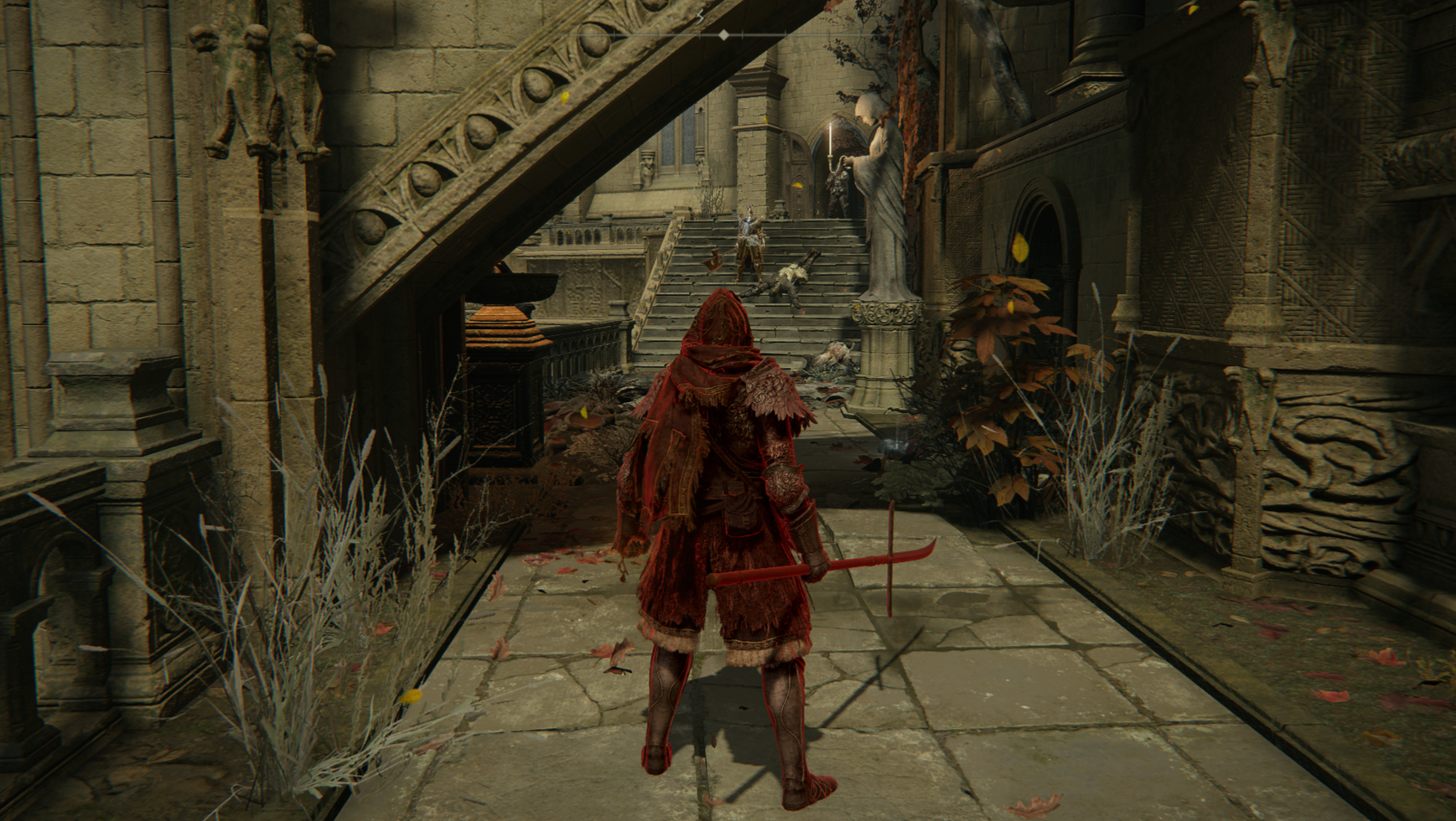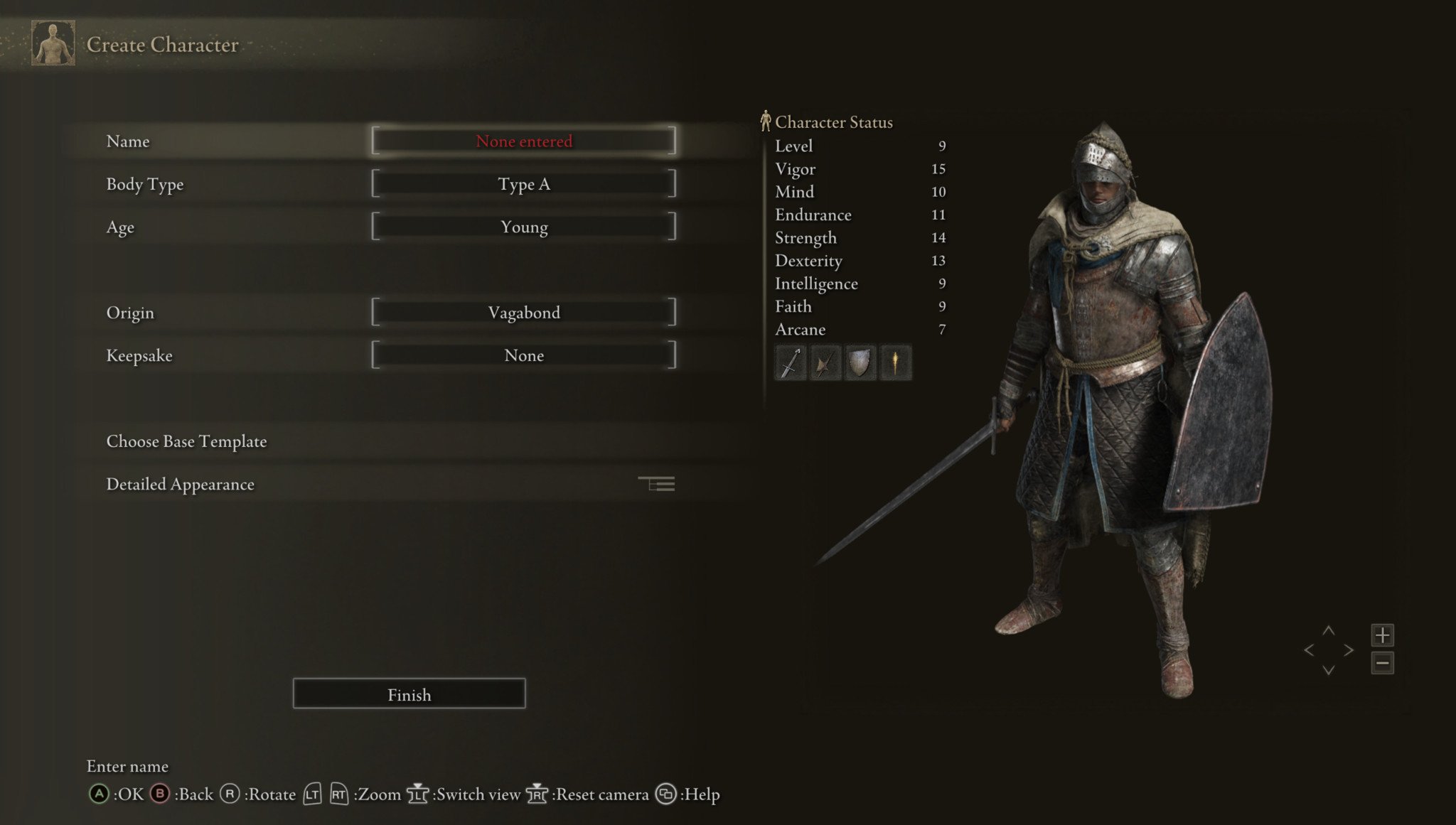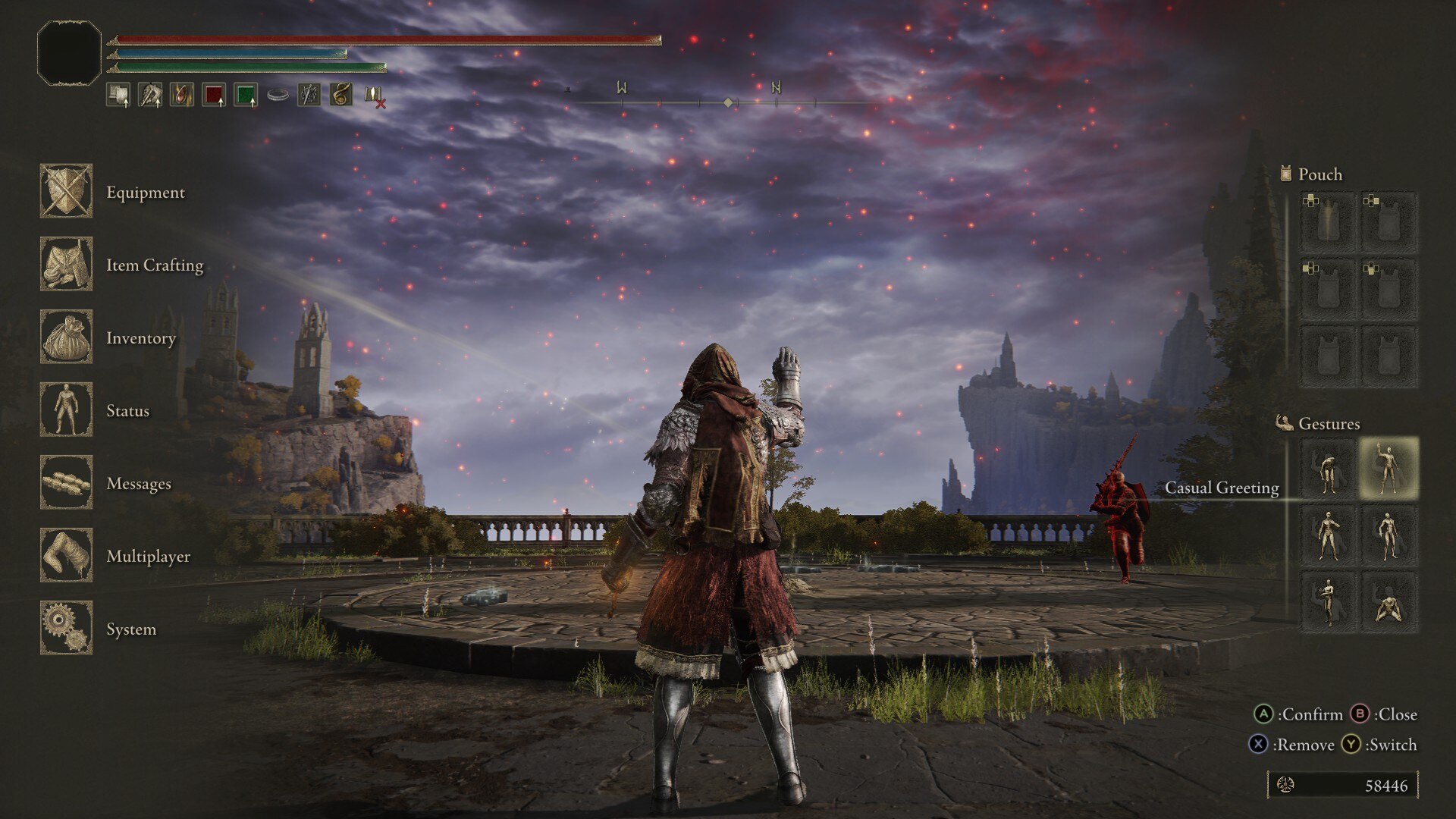Elden Ring PvP guide: Builds, level, arena, and more
Interested in hunting your own kind, Tarnished?

While Elden Ring is ultimately a PvE game at heart, that doesn't mean that the PvP side of it isn't worth diving into. PvP can be a fun way to test your mettle (and your build) against opponents, and since Elden Ring has an incredible amount of build diversity, engagements with other players are often uniquely exciting. However, before jumping into PvP, you need to know how it works, what Elden Ring's community-driven PvP rules are, and more.
In this guide, we'll provide a complete overview of everything you need to know about Elden Ring PvP. This includes the three types of PvP you can engage with, how to put together a strong PvP build, the multiplayer items you'll need, Elden Ring's PvP meta level and level ranges, where to go for duels, and plenty of other information.
Elden Ring PvP multiplayer details: How it works
In Elden Ring, there are three types of PvP that you can participate in: invasions, duels, and co-op. In the sections below, we'll go over each type of PvP experience in detail and explain how they work.
Invasions
Invasions are a form of PvP in which you can invade another player's world as a "Bloody Finger" or "Recusant" and attempt to kill them. As an invader, the enemies in the level will not target you, and your compass will also show you which direction you need to go in to find the host player (dubbed the "Host of Fingers" in-game). Additionally, you're also given three Phantom Bloody Finger items at the start of each invasion that allow you to teleport to a new spawn location in the level if you want to retreat or approach the Host of Fingers from a different angle.
Even with these utilities and benefits, though, you're ultimately at a disadvantage when invading. This is because the host can summon two "Furled Finger" cooperators to make it a 3v1 fight, and unless the host is using the Taunter's Tongue item, you'll only be able to invade worlds with multiple players in them. On top of this, you only get half of your healing and mana flasks each time you invade, and you're not allowed to use a Rune Arc to activate a Great Rune like the host is, either. You can even get hit by large enemies and minibosses in the level, though they'll never actively target you.
Despite these weaknesses, though, it's far from impossible for invaders to take down the host and win the day. Smart invaders can even the odds by baiting the host and their allies into groups of PvE mobs, and they can also hide around corners and behind cover to set up ambushes. Many of the Ashes of War and spells in Elden Ring can also hit multiple players at once, giving outnumbered invaders viable ways to attack a "gank squad."
Duels
For those looking to battle mono a mono with other players in fair and even engagements, duels are the best PvP option. Duelists can't forcibly invade worlds and are instead directly summoned by host players. They still only get half of their flasks and can't use Rune Arcs, though, and as a result, using healing flasks or Rune Arcs in duels is strongly frowned upon by the PvP community (we'll touch on Elden Ring PvP etiquette in more detail later).
All the latest news, reviews, and guides for Windows and Xbox diehards.
Co-op and 'Hunting'
If you want to PvP but would prefer to fight invaders instead of becoming one, try jumping into Elden Ring co-op as a Furled Finger summon. In addition to helping the host with the level's enemies, minibosses, and main boss, it's also your job to defend them from any invaders that arrive. Note that like invaders, Furled Finger summons only get half of your flasks and can't use a Rune Arc to activate your equipped Great Rune.
Another way to help hosts is to activate the Blue Cipher Ring item, which will automatically summon you into worlds that have invaders in them as a Hunter. Like Furled Finger cooperators, you can damage level enemies, but your ultimate purpose is to hunt and kill the invader. Once they die, your objective will be completed and you'll be removed from the host's world. Note that if you're a host and you want Hunters to arrive in your world when invaded, you'll need to activate the White Cipher Ring item.
Elden Ring PvP multiplayer: Items you'll need
To participate in the forms of PvP described above, there are a variety of different multiplayer items you'll need. In the table below, we've listed all of the important multiplayer items in the game, including their names, what they do, and where you can find them in the Lands Between.
| Item name | Function | Location |
|---|---|---|
| Festering Bloody Finger | Invade another player's world (single-use) | Sold by various Nomadic Merchants and Patches in Murkwater Cave. Also given by White Mask Varre at the Rose Church in Liurnia of the Lakes. |
| Bloody Finger | Invade another player's world (reusable) | Given by White Mask Varre at the Rose Church in Liurnia of the Lakes during his questline. |
| Recusant Finger | Invade another player's world (reusable) | Found on a table within the Volcano Manor in Mt. Gelmir. |
| Duelist's Furled Finger | Creates competitive multiplayer sign (reusable) | Found in front of the large coliseum-like structure in northern Limgrave. |
| Small Red Effigy | Sends competitive multiplayer sign to nearby summoning pools (reusable) | Found in front of the large coliseum-like structure in northern Limgrave. |
| Tarnished's Furled Finger | Creates cooperative multiplayer sign (reusable) | Found at the start of the game's first area, located on the ground just after the large wooden door and Site of Grace. |
| Small Golden Effigy | Sends cooperative multiplayer sign to nearby summoning pools (reusable) | Acquired when activating a summoning pool for the first time. |
| Furlcalling Finger Remedy | Allows a host to see cooperative and competitive multiplayer signs (single-use) | Can be crafted with 2x Erdleaf Flowers. Can also be found throughout the Lands Between. |
| White Cipher Ring | Allows hosts to request the aid of a Hunter when invaded (reusable) | Sold by the Twin Maiden Husks in the Roundtable Hold for 1,000 runes. |
| Blue Cipher Ring | Allows Hunters to answer requests for aid from invaded hosts (reusable) | Sold by the Twin Maiden Husks in the Roundtable Hold for 1,000 runes. |
| Taunter's Tongue | Allows hosts to be invaded when playing solo. Also reduces the cooldown period between invasions. Can only be used after using a Furlcalling Finger Remedy. | Drops after defeating the NPC invader Mad Tongue Alberich. |
| Finger Severer | Allows players to send other players (or themselves) home. Does not work on invaders, but does work on duelists. (reusable) | Found at the start of the game's first area, located on the ground just after the large wooden door and Site of Grace. |
Elden Ring PvP level: Meta and invasion range

To promote build diversity and prevent players from being able to use all types of weapons and spells effectively, Elden Ring's PvP community has decided to make the game's "meta level" 125. As a result, the best way to find as many players as possible for duels is to stick to level 125, and most invasions in Elden Ring's endgame areas occur at level 125 as well. Something important to note, however, is that Elden Ring's PvP is still very healthy above this level — you'll still be able to find tons of duels and engage with plenty of lategame invasions at level 150, and a fair number of players like to duel at the level 151-200 range as well. For the best experience, though, we recommend leveling no further than 125-150.
If you want to invade players in particular areas throughout the Lands Between, it's also important to understand what level most players are at and how upgraded their weapons are when they play through each location. This is because Elden Ring prevents high-level invaders with highly upgraded weapons from being able to invade players that have a lower level and weaker gear. In the table below, we've listed the level and weapon upgrade level that PvP players should stick to when planning to invade in a specific area.
| Location | Player level | Upgrade level (Somber) |
|---|---|---|
| Limgrave West | 1-15 | +0-1 (+0) |
| Stormhill | 10-20 | +1-2 (+0-1) |
| Limgrave East | 10-20 | +2 ( +1) |
| Weeping Peninsula | 20-30 | +3 (+1) |
| Stormveil Castle | 30-40 | +3-4 (+1-2) |
| Liurnia of the Lakes (South) | 40-50 | +3-4 (+1-2) |
| Academy of Raya Lucaria | 50-60 | +4-6 (+2-3) |
| Liurnia of the Lakes (East) | 50-60 | +4-6 (+2-3) |
| Ainsel River | 50-60 | +6-8 (+2-3) |
| Liurnia of the Lakes (West) | 60-70 | +8-12 (+3-4) |
| Siofra River | 60-70 | +8-12 (+3-4) |
| Caelid | 60-70 | +10-14 (+4-5) |
| Altus Plateau | 60-70 | +10-14 (+4-5) |
| Nokron, Eternal City | 70-80 | +15-20 (+6-8) |
| Siofra Aqueduct | 70-80 | +15-20 (+6-8) |
| Deeproot Depths | 80-90 | +15-20 (+6-8) |
| Mt. Gelmir | 80-100 | +15-20 (+6-8) |
| Lake of Rot | 80-100 | +15-20 (+6-8) |
| Dragonbarrow | 90-110 | +15-20 (+6-8) |
| Leyndell, Royal Capital | 90-110 | +15-20 (+6-8) |
| Forbidden Lands | 100-120 | +20-24 (+8-9) |
| Mountaintop of the Giants | 100-120 | +20-24 (+8-9) |
| Consecrated Snowfield | 100-120 | +20-24 (+8-9) |
| Mohgwyn Palace | 110-140 | +20-24 (+8-9) |
| Miquella's Haligtree | 120-150 | +20-25 (+8-10) |
| Crumbling Farum Azula | 120-150 | +20-25 (+8-10) |
| Leyndell, Ashen Capital | 120-150 | +25 (+10) |
Elden Ring PvP builds and how to make them
Now that you've got a good understanding of how PvP works, have the items you need, and know what level range you should aim for with your character, the next step is putting a PvP build together. We won't go over specific builds here — check out our best Elden Ring builds guide for those — but we will cover important things to keep in mind when making a build, as well as some ways you can optimize a build for PvP instead of PvE.
At the heart of any powerful PvP build, you'll find a min-maxed stat spread that was built with stat softcaps in mind. Each character stat you can level up has a handful of softcap values, and each time you reach a softcap, further levels in that stat will provide weaker and weaker benefits. For example, 60 is the final softcap for Vigor, so leveling the stat above it will yield meager increases to your HP instead of substantial ones. Note that while a stat's first softcap will only reduce the benefits of additional levels slightly, further softcaps reduce them much more. Never level a stat beyond its final softcap when making a PvP build.
Since you only have 125-150 levels available before you start to push beyond Elden Ring's meta, you need to target softcaps to get as much value out of your levels as possible. The only stat softcaps you should never try to hit are the ones for Mind and Endurance, as the amount of FP and stamina they provide at that point is overkill. The table below shows all of the softcaps for each character stat in Elden Ring.
| Stat | Softcaps |
|---|---|
| Vigor | 40/60 |
| Mind | 55/60 |
| Endurance | 50 (Stamina), 25/60 (Equip Load) |
| Strength | 20/55/80 |
| Dexterity | 20/55/80 |
| Intelligence | 20/50/80 (Attack Rating), 60/80 (Sorcery Scaling) |
| Faith | 20/50/80 (Attack Rating), 60/80 (Incantation Scaling) |
| Arcane | 20/50/80 (Attack Rating), 30/45 (Incantation Scaling) |
While every build needs Vigor for HP and at least some Endurance for stamina, you should choose the other stats you level based on the gear you want to take into combat. Keep an eye on the stat requirements of the weapons and spells you want to use, as well as the stat (or stats) their damage scales best with. For example, you'll need plenty of Strength if you want to effectively use large weapons and shields, as these items require a lot of Strength to wield and generally have B, A, or even S-grade damage scaling with it. Weapons that are smaller and swing quickly generally work best with lots of Dexterity, while medium-sized weapons like halberds and spears often benefit the most from a hybrid build that utilizes Strength and Dexterity.
Staves and the sorceries you can cast with them are almost completely Intelligence-based, while Sacred Seals and incantations scale highly with Faith. Weapons that scale strongly with Arcane are few and far between, but the stat does improve your ability to inflict status effects like Bleed, Poison, and Scarlet Rot. On top of that, it's also the primary stat for Dragon Communion incantations, which are some of the strongest spells in Elden Ring. No items in the game benefit from Mind, but it's important to have a decent amount of it if you're a caster or you like using your weapon's Ash of War frequently since spells and Ashes of War use the FP it provides.
If you're having a hard time deciding which weapons and/or spells you should use for your build, we recommend checking out our lists of the best Elden Ring weapons and the best Elden Ring spells. The vast majority of them can be very effective in PvP, and are also great for PvE as well.
Also, if you're unsure of how much you should level up each stat, we've provided some suggestions in this list below. You can also use tools like the Elden Ring Build Planner and the Elden Ring Starting Class Optimizer to figure out which class you should choose and how many points you'll need in each stat to optimize your character's effectiveness with your chosen weapons and build type.
- Vigor: All PvP builds should have at least 50 Vigor. 60 is generally ideal since attacks in Elden Ring do more damage on average than they did in previous FromSoftware games.
- Mind: Casters should aim for 25-35 Mind. Reduce this to 15-20 if you like using Ashes of War frequently. Don't level it at all if you don't care about magic or Ashes of War.
- Endurance: Melee fighters should aim for 30-35 Endurance since they need plenty of stamina for attacking and dodge rolling, and being able to use heavier armor helps too. Casters can reduce this to 20, as their ranged playstyle means they don't need to dodge as much and can get away with light armor.
- Strength: Since damage across the board in Elden Ring is very high, many PvP players stop at the 55 softcap for Strength. Alternatively, some level Strength up to 66-70 and use your weapon with two hands to effectively get 99 Strength since two-handing raises your effective Strength by 50%.
- Dexterity: The 55 softcap is a good stopping point for PvP Dexterity builds, though players generally like increasing this to around 70 beyond the level 125 meta.
- Intelligence: Sorcerers should level Intelligence to at least 60 for strong spell and weapon damage. Increasing Intelligence to the final softcap of 80 is a viable option as well, though it's generally best to do this with level 150 builds.
- Faith: Like sorcerers, incantation users want at least 60 Faith to deal effective damage with spells and Faith weapons. Raise this to 80 if you're going to Level 150.
- Arcane: Don't level Arcane at all unless you're using one of Elden Ring's rare Arcane-scaling weapons or Dragon Communion incantations. Level to 20 Arcane if the weapon you're using has mediocre Arcane scaling, but don't be afraid to go up to 50 if the scaling is better (B-grade or above). Going up to 80 Arcane is effective for Level 150 builds that utilize both Arcane weapons and Dragon Communion spells.
With your weapons, spells, and stats situated, the last step is choosing armor and talismans to wear. As a general rule of thumb, you should always wear the heaviest armor you can that doesn't give you a Heavy Load, as being overencumbered reduces your ability to dodge roll effectively. This is because heavier armor provides better protection and poise, which reduces the damage you take from hits and increases your ability to finish attacks without being stunned out of them, respectively. Alternatively, you can also choose to wear armors that provide passive stat boosts, such as increased sorcery damage or some extra Mind. These are generally less protective than other armors and give less poise, but can still be worth using. For some great armor that works well in PvP (as well as PvE), check out our list of the best Elden Ring armor sets.
The best talismans are the ones that support your playstyle and core stats with helpful stat bonuses, damage buffs, and other beneficial effects. For example, players using a Strength build that utilizes a large weapon and heavy armor will benefit greatly from using talismans like the Great Jar's Arsenal and the Erdtree's Favor, as they make it easier to equip this gear without having a Heavy Load. Meanwhile, mages will get lots of value from the Graven-Mass Talisman, as it significantly boosts the damage of sorceries. One talisman that all players using a PvP melee build should consider is the Bull Goat's Talisman. It gives a huge boost to your poise and allows you to trade hits with other players rather than get staggered out of your attack whenever your opponent damages you first.
Elden Ring PvP arena: Where to duel
So, you've put together your PvP build and you're ready to try dueling, but Elden Ring doesn't have dedicated duel arenas or duel matchmaking like Dark Souls 3 did. Where in the Lands Between should you go if you're looking to 1v1?
There are a handful of different places that players like to duel, but the main one is the Main Academy Gate Site of Grace located right by the entrance to the Raya Lucaria Academy in Liurnia of the Lakes. The vast majority of players duel here since the large and flat circular platform gives duelists plenty of room to work with while fighting. Also, since this spot can be reached swiftly after starting a new game, players who use trading and item duplication glitches to equip a fresh character with gear and plenty of runes for rapid leveling can jump into PvP duels incredibly quickly.
Some other notable dueling locations include The First Step Site of Grace in Limgrave, as well as the Outer Wall Phantom Tree Site of Grace in the Altus Plateau region. The First Step is directly accessible at the start of the game and is a great place for low-level duels, but there's not nearly as much room there as there is with the Main Academy Gate area. Meanwhile, the Outer Wall Phantom Tree is just as open as the Main Academy Gate is, and the tree located there shakes things up by offering duelists cover from their opponent's ranged attacks, but it's located further into the game.
Elden Ring PvP multiplayer: Rules and etiquette
While Elden Ring PvP doesn't have any official rules, the community has developed some guidelines that players should follow and keep in mind while participating in PvP activities. Generally, there are significantly more guidelines for duels than there are for invasions, though there are some things you should avoid doing in invasions, too.
Duels are intended to be fair and respectful one-on-one fights, and as a result, the following rules help ensure that type of gameplay experience while dueling:
- If playing as a host, do not begin spamming your opponent with attacks as they're spawning in.
- Greet your opponent with a friendly gesture. Players typically use the Wave or Casual Greeting gestures.
- You may buff your character with spells, consumables, and your Flask of Wondrous Physick. However, use of the Cerulean Hidden Tear, Leaden Hardtear, and Winged Crystal Tear in the flask is frowned upon since infinite FP, infinite poise, or a huge reduction to your Equip Load provides a massive advantage in duels.
- Do not heal the HP loss caused by the Seppuku Ash of War buff or the Fire's Deadly Sin incantation, as taking advantage of these buffs without dealing with their drawbacks is frowned upon.
- Indicate you're ready to begin by performing the Bow gesture as a sign of respect. Do not attack your opponent until they've buffed and performed a bow as well.
- Do not use healing flasks or Rune Arcs to activate a Great Rune during the duel. You may use FP flasks, however.
- You may heal with healing incantations during the fight, as they're considered part of your build and require strategic timing to be successfully cast.
- Do not make use of exploits that take advantage of bugs or glitches in the game.
- If you win the duel, perform a respectful bow. Do not "teabag" or perform rude gestures.
If the player you're dueling starts spamming attacks right as you spawn in, acts rude, heals with flasks during your fight, or uses exploits, it's recommended to perform the Point Down gesture and use the Finger Severer to either send them home or go back to your home world yourself. This communicates to your opponent that they performed inappropriately for the duel.
Unlike duels, invasions have very few guidelines, and due to their inherently rude nature, things like the use of healing flasks and "cheap strategies" such as ambushes are perfectly fine. With that said, there are still some things that both the invader and the host should avoid doing during invasions. Here are the community guidelines for invading:
- Like with duels, making use of unfair exploits that take advantage of bugs or glitches is considered "maidenless behavior."
- As an invader, it's strongly frowned upon to try to bait the host into hitting an NPC in their world by standing near them. This is because the NPC will become hostile to the host, and if they don't have Celestial Dew to "atone for their sins" at the Church of Vows, they will be unable to continue the NPC's questline in that playthrough.
- As a host, it's strongly frowned upon to use Torrent to get to a location inaccessible by foot, then activate the Taunter's Tongue and go AFK. This is because Torrent cannot be used in multiplayer, resulting in a situation where invaders can't reach you and are forced to use the Finger Severer, which rewards the host with runes and a Rune Arc. Note that AFK farming is a bannable offense. If you come across someone AFK farming, capture visual proof and report them to Bandai Namco Support.
Elden Ring PvP multiplayer: Tips and tricks
PvP in Elden Ring can be difficult, especially if you end up going against skilled opponents using powerful PvP builds. Above all else, the best way to "git gud" at PvP encounters is to practice and get experience under your belt. With that said, the following tips and tricks will help you succeed more often whether you're dueling, invading, or hunting an invader yourself.
- Never stay in one place for long. By constantly moving around, you make it harder for your opponent to correctly judge when to attack. If they miss, you can punish them with a hit of your own.
- Don't try to use fully charged heavy attacks or spells unless you have a good distance from your opponent or a lot of poise. Charged attacks may deal more damage, but they take longer, and your opponent can easily stun you out of them with light attacks if they're near you.
- If your opponent is effectively dodging your attacks, try switching up the timing of your strikes by using heavy attacks. If you're still unable to land hits, you can mix up your moveset even further by slightly charging your heavies before attacking. This also works with many sorceries and incantations.
- You can perform running attacks by sprinting before performing a light or heavy attack. These attacks come out very quickly and can be hard to dodge. Also, halberds, spears, and thrusting swords have a forward poke with great range as their running attack. Use it to hit opponents that are running or rolling away from you.
- You can also "roll catch" opponents by slightly delaying follow up attacks when they attempt to dodge away. If someone is roll catching you, the best way to counter it is to stop yourself from "panic rolling" and patiently wait until you see your opponent begin their attack.
- By crouching and then quickly light attacking, you can perform a unique crouch attack. These attacks are very fast and can be used to catch opponents expecting normal attacks off-guard. They're especially powerful on greatswords and colossal swords, as most crouch attacks with these weapons are powerful forward thrusts with great range.
- If you're using multiple spells, organize them in your action menu (the plus-shaped hotbar) so that the ones you use more often are at the start of it. This way you can quickly access them by holding up on the D-pad, which instantly selects the first spell in your loadout.
- Many of the area-of-effect spells and Ashes of War in Elden Ring can be avoided easily by running to the side. However, you can catch your opponent off-guard by "free aiming" them at the spot where your opponent is running to. This can be achieved by turning off your target lock and turning your character towards where you want to land the spell while casting it. If the spell or Ash of War has an arc, you can use the right thumbstick to adjust what height you throw it at as well.
- If your opponent is near an environmental hazard like an abyss, you can try to knock them into it with explosive spells and Ashes of War like the Giantsflame Take Thee incantation. This is much easier to pull off if they don't see you coming, so try to set up an ambush near a hazard.
- If an invader with a melee build arrives while you're fighting a miniboss in the open world with the host/your summons, it's best to stay close to the boss. This is because the invader will be forced to get close to try to hit you, and while the boss won't attack them directly, they will take damage if they're hit by a boss' attack.
Does Elden Ring have PvP rewards?
While FromSoftware's previous games have had specific PvP rewards for each multiplayer covenant you could be a part of, Elden Ring doesn't have covenants. As such, the only multiplayer rewards available in Elden Ring are Rune Arcs and runes you can use for leveling. In PvP, you can get a Rune Arc if you kill the host as an invader or duelist, or kill an invader or duelist as a host, co-op summon, or Hunter.
Rune rewards, though, are more complicated. When you kill another player in PvP, you get a fixed amount of runes that's wholly dependent on the level of the person you defeat. The number of runes you get is determined by how many runes the killed player last used to level up, but you only get a percentage of these runes. This percentage varies based on what type of PvP you're doing and what role you're playing.
- Killing an invader as a host awards you 15%.
- Killing an invader as a co-op summon or Hunter awards you 5%.
- Killing a host, co-op summon, or Hunter as an invader awards you 4%.
- Killing a duelist as a host awards you 2%.
- Killing a duelist as a co-op summon awards you 1%.
- Killing a host or co-op summon as a duelist awards you 1%.
- Killing an invader as another invader awards you 1%.
Get in there, Tarnished!
Now that you know how Elden Ring PvP works, have all the items you need, have created an effective build, know what the rules and guidelines of PvP are, and have some gameplay tips and tricks up your sleeve, you're ready to jump into some PvP action. You'll likely struggle for a while since you're just starting out, but don't give up. With practice, patience, and persistence, you'll eventually become a force to be reckoned with whether you're dueling, invading, or protecting hosts by hunting down their assailants.
Elden Ring is finally here, and it's available for $60 on Xbox Series X|S, Xbox One, PS5, PS4, and PC. It's one of the best Xbox games you can play right now if you're a fan of challenging RPGs, and we strongly recommend it.
Elden Ring
Elden Ring is FromSoftware's latest fantasy epic, featuring a focus on open-ended design in a universe created by both FromSoftware president Hidetaka Miyazaki and A Song of Ice and Fire author George R.R. Martin.
Buy from: Microsoft | Amazon | GMG (Steam)

Brendan Lowry is a Windows Central writer and Oakland University graduate with a burning passion for video games, of which he's been an avid fan since childhood. He's been writing for Team WC since the summer of 2017, and you'll find him doing news, editorials, reviews, and general coverage on everything gaming, Xbox, and Windows PC. His favorite game of all time is probably NieR: Automata, though Elden Ring, Fallout: New Vegas, and Team Fortress 2 are in the running, too. When he's not writing or gaming, there's a good chance he's either watching an interesting new movie or TV show or actually going outside for once. Follow him on X (Twitter).










